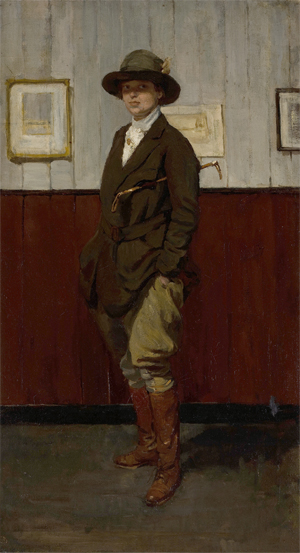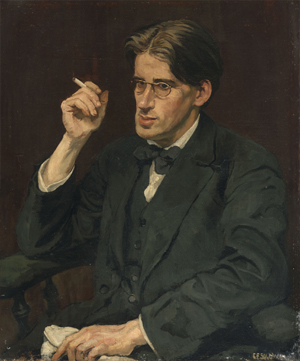ESTELLA SOLOMONS: STILL MOMENTS
Published in Issue 6 (November/December 2022), News, Volume 30National Gallery of Ireland until 8 January 2023
By Niamh MacNally

Above: Reminiscent of the work of her former tutor at the Metropolitan School of Art, William Orpen, Woman in Riding Habit depicts the poet and writer Kathleen Goodfellow. (Trustees of the Estate of Estella Solomons)
This exhibition, dedicated to the Irish artist Estella Solomons (1882–1968), comprises eighteen artworks, with loans drawn from public and private collections across the island of Ireland. It also includes items from the Estella Solomons and Seumas O’Sullivan archive, housed in the Library of Trinity College, Dublin, which shed light on her political associations in what was a turbulent period in Ireland’s history.
A committed nationalist and a member of Cumann na mBan, Solomons painted many of the leading revolutionary and cultural figures of the time. Her unsentimental portraits, painted during quiet moments in her studio, convey a powerful psychological intensity, with sitters caught in private moments of introspection.
Solomons was from a distinguished Jewish family who had come to Dublin from England in 1824. Her parents, known for their philanthropy and promotion of Jewish education, helped to establish the new Adelaide Road Synagogue in Dublin in 1892. In 1910 she rented a studio at the top of 17 Great Brunswick (now Pearse) Street. Here she befriended the novelist, poet and republican James Stephens, who lived in the flat below. Stephens later dedicated The charwoman’s daughter (1912) to her brother Bethel, who later became master of the Rotunda Hospital (1926–33) and president of the Dublin Jewish Progressive Congregation (1946–65).
Solomons was not only a sensitive portraitist but also an accomplished etcher and landscape painter. During the War of Independence she obtained official passes in order to sketch in military zones. Her etchings of ‘old Dublin’ were created at a time when the city had the highest mortality rate in Europe. She installed an etching press in her studio in 1916, taught etching in Bolton Street for the Dublin Municipal Technical Schools, and printed Dublin scenes for exhibition. Her etchings were reproduced in Padraic Colum’s The road round Ireland (1926) and D.L. Kelleher’s The glamour of Dublin (1928).
Thanks to Solomons’s well-to-do background, she was not reliant on commissions but instead drew her subjects from her immediate family and wide circle of artistic, literary and nationalist friends. Reminiscent of the work of her former tutor at the Metropolitan School of Art, William Orpen, Woman in Riding Habit depicts the poet and writer Kathleen Goodfellow. The women became lifelong friends, having first met during the Easter Rising while sheltering from snipers’ bullets on Mount Street. In 1917 they enlisted in the Ranelagh branch of Cumann na mBan, where they were taught first aid, home nursing, drill and signalling by Phyllis Ryan, the future wife of Seán T. O’Kelly. As a Cumann na mBan member, Solomons hid ammunition for IRA Volunteers under lettuces that she had planted in her parents’ garden on Waterloo Road and delivered them to an agent known as ‘the Butterman’ in Baggot Street. He taught her how to fire a revolver and in exchange she painted a portrait of his wife. Kathleen Goodfellow’s book Three tales of the times (1921), written under her pseudonym ‘Michael Scot’ and describing the atrocities of the Black and Tans in Ireland during the War of Independence, also features in the exhibition.

Above: Portrait of Frank Gallagher, one of several conveying their subjects’ own strong sense of character. (Trustees of the Estate of Estella Solomons)
Solomons’s studio was seen as a ‘safe house’ for insurgents, several of whom sat for her. It was often raided during the Civil War by Free State troops owing to her support for the anti-Treaty side. Solomons’s husband, the poet and editor Seumas O’Sullivan (born James Sullivan Starkey), whose portrait features in the exhibition, recalled that her studio was ‘a centre of quiet, of calm; a place of refuge for many whose political and national activities had brought them a very undesirable amount of notice in “the bad times”’. Her painting On Parole (1920) evokes the tension of the times through the sitter’s inward-looking expression and furrowed brow.
Several other compelling portraits feature in the exhibition. The Portrait of Seán Milroy skilfully conveys the sitter’s commanding presence through his direct and unflinching gaze. Milroy, a friend and political ally of Arthur Griffith, took part in the Easter Rising, was elected to the Second Dáil in 1921 and served in Seanad Éireann from 1928 to 1936.
Another captivating and lively portrait is of the writer and political activist Alice Milligan. Despite her Methodist and unionist background, Milligan became a leading literary figure in the Irish cultural revival. She was an avid supporter of Eamon de Valera and in the 1930s became a founding member of the Anti-Partition League. Portraits of George Russell (AE), Frank Gallagher, Joseph Campbell and Darrell Figgis are also on show, each one conveying its subject’s own strong sense of character. Fascinating letters, dated 1923, to Solomons from Frank Gallagher and Ernie O’Malley, while incarcerated in Kilmainham Gaol, highlight the friendship and support that she gave to her comrades.
After the Civil War Solomons moved away from painting portraits. Following her marriage in 1926, she devoted much of her time to The Dublin Magazine, an influential literary journal edited by her husband that ran for 35 years. The range of portraits on show, however, reveal the artist’s lasting contribution to our understanding of Irish history and the individuals involved.
Niamh MacNally is Curator of the Prints and Drawings Study Room at the National Gallery of Ireland.
(The exhibition is supported by the Department of Tourism, Culture, Arts, Gaeltacht, Sport and Media under the Decade of Centenaries Programme 2012–23.)
















